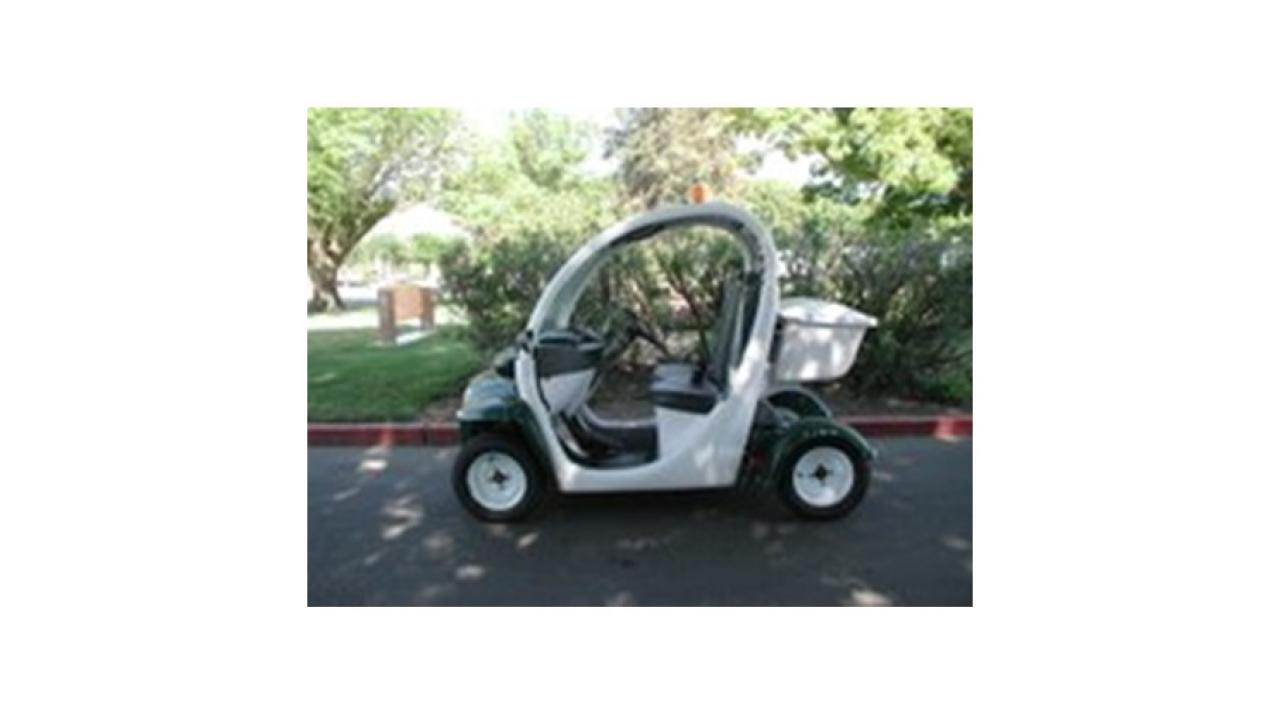
Departments Working Together Towards Solutions
By Departmental Staff
Working on motor vehicles can be a back aching job, just ask the employees of Fleet Services.
Dr. Buster Porter, Physical Therapist and Ergonomics Specialist with Occupational Health Services, was concerned about an employee from Fleet Services who was experiencing ongoing work related injuries to his back. Dr. Porter decided to visit the employee’s work environment to get a better sense of the tasks that were creating the injuries. UC Davis uses electric GEM (Global Electric Motorcars) carts on campus, and these vehicles operate on a 72-volt battery system and plug into a standard 110-volt outlet for recharging. There are six batteries weighing 70 lbs. each in every GEM cart. These batteries need to be serviced monthly, which requires that a mechanic remove the batteries from the cart. Unlike a standard vehicle with an engine compartment, GEM batteries are deeply embedded in the vehicle, set as low to the base as possible for stability. Observing the removal process, it became obvious that manually removing and replacing these batteries was causing the injuries.
Dr. Porter contacted Dr. Fadi Fathallah at the Department of Biological and Agricultural Engineering in the College of Engineering to discuss his concern. Dr. Fathallah and his colleague Dr. Ruihong Zhang posed the problem to students in the program. Seniors David Hoang and Lena Nguyen decided to commit to the project and design an ergonomic lift system that could assist with removing the batteries.
The initial step was to go to Fleet services and complete a pre-assessment. Hoang and Nguyen used a Lumbar Motion Monitor device to record the forces on the lumbar spine when the batteries were manually removed from the car. The results showed that the pressure was twice what is recommended to avoid developing a low back injury and were classified as “High Risk”.
Now, the challenge was to develop a safe, efficient and ergonomic lift system. Hoang and Nguyen originally planned a unit with pulleys and chains but eventually modified the design to be a hydraulic jack with an extending overhanging arm as well as a base that could slide underneath the cart. Their unit was engineered to withstand significantly greater weight and force than would be necessary. After reviewing the lift with their faculty advisors the detail for the device was given to Burt Vannucci, Lab Mechanician, to fabricate it.
The completed product was tested and measured at Fleet Services. The calculated compression loading on the spine was 1442 lbs. when the procedure was done manually and 640 lbs. when the new hydraulic jack was used. The National Institute for Occupational Safety & Health (NIOSH) sets the “Action Limit” at 670 lbs. The team’s findings clearly favored the use of a lift in the prevention of injuries from this type of vehicle service. Hoang and Nguyen felt that improvements could be made, such as adding an electrically operated hydraulic pump which could further reduce flexion of the spine. PG&E Fleet Services in Davis is interested in and has committed to furthering the collaboration of the battery lifting device in hopes of forwarding the design for application in industry. This is an exciting potential opportunity that would allow the students to tangibly see their work go from classroom design to industrial application.
Currently, Dr. Porter is interested in finding a solution for workers in Veterinary Medicine who work with premature foals and must physically lift the animals to avoid putting strain on their underdeveloped limbs. The collaboration between departments, faculty, staff and students opens the door for other projects, as the university environment provides unique opportunities for project partnerships between departments. Safety Service’s upholds the vision of UC Davis by fostering the collaboration of faculty and young scholars in meeting the needs of individuals through academic and practical advances, and its mission is to foster collaboration and partnership and also to advocate for prevention strategies in its service of the UC Davis campus. The new ergonomic battery lift created for Fleet Services was the embodiment of that goal and has paved the way for other problem solving ventures in the future.
This is the first in a series of articles submitted by Dr. Porter. He has the unique position of seeing job hazards and witnessing departments work toward solutions, including bringing in the bright minds of students. Look for the next article in the series: “From Occupational Hazards to Occupational Health.”
